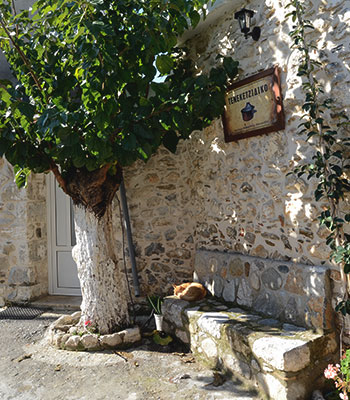 Avdou village is 38km east of the city of Heraklion and 15km from the Chersonissos village on the road leading to the Lasithi Plateau. The village of Avdou is located in the Cretan hinterland, in a semi-mountainous location at the foot of Mount Selena and at an altitude of 230 meters.
Avdou village is 38km east of the city of Heraklion and 15km from the Chersonissos village on the road leading to the Lasithi Plateau. The village of Avdou is located in the Cretan hinterland, in a semi-mountainous location at the foot of Mount Selena and at an altitude of 230 meters.
The village of “Avdou”, according to tradition, was named after the name of the prophet Avdios whose temple was in the place of Kontaria or Lines. Nowadays, about 300 people live permanently in Avdou. The area is characterized as a rural mountainous settlement located in the middle of the plain of Lagada. The main occupations of the inhabitants are agriculture and livestock farming while they produce excellent quality of oil, wine and vegetables.
The earliest recorded reference to the place name “Avdou” was in 1381, in a Venetian state document where the area was mentioned as a feudal estate belonging to Michel Quirino. However, according to the archaeological findings, Avdou is a historic village with ancient roots in the Minoan culture over the centuries. It is no coincidence that the French professor, Paul Faure, claims that one of the hundred big cities of Crete (“ekatopolis” in Homer) was placed in the wider Avdou region. The Minoan settlement of Spiliaridia, the two sacred caves, Agia Fotini and Faneromeni, as well as the foundations of early Christian churches and buildings in various places lead to the conclusion that, since ancient times, there has been a continuous economic and cultural flourishing of the area.
Avdou is a village with remarkable historical monuments of Byzantine art. Byzantine and post-Byzantine churches are scattered in the area and are invaluable monuments of cultural and artistic heritage. Some of them are the church of Agios Konstantinos, which, according to a historical inscription, was built in 1445 and has very interesting frescoes in vibrant colors on its walls and the church of Agios Konstantinos which is a simple one-storied temple with frescoes by the hagiographers Manuel and Ioannis Fokas, important representatives of the Constantinopolitan art in Crete.
In addition, there is the church of Agios Antonios which has got frescoes dating back to the 13th century, the church of Agios Georgios with frescoes dating back to the 14th-15th century and the church of Agia Anna, a semi-paved temple in an idyllic landscape and at an altitude of 700m near the cave of Agia Fotini. Lastly, there is Panagia or Kerapanagia (Zoodohos Pigi) which is a church known for the great revolutions happened during which the chieftains were secretly gathering and swearing faith in the sacred fight. The Agia Fotini cave is located south of the settlement, on the slopes of the “Louloudaki” hill, at an altitude of 768m. Close to Agia Fotini cave, at an altitude of 770m, is the cave of Faneromeni, there were findings of Late Minoan, Hellenistic and Roman times, which testify the worship of the cave. Moving towards the monastery of Agios Ioannis and Agia Anna, there is a landscape of a special natural beauty, a forest with kermes oaks, the evergreen oaks and maples. The forest reaches until “Alonaki” location at an altitude of about 700m where the view is panoramic.
Avdou is the birthplace of the archaeologist Stefanos Xanthoudides, of Nikolaos Kagiambis, who acted during the Revolution of 1821, fought in Messolonghi and was a standard bearer of Karaiskakis, and of Ioannis Dafotis, who distinguished himself in the Revolution of 1897. For the above mentioned reasons, Avdou has also acquired the name Kapetanohori (i.e. the village of captains).
The picturesque Avdou, despite its small size in number of inhabitants, is pulsing in summer because of the many cultural events in the square of the village. Concerning the events in the village of Avdou, the Cultural Association of Avdou organizes the Xanthoudideia every year. Xanthoudideia is a series of daily events during which visitors and locals have the opportunity to experience Cretan and other kinds of musical evenings as well as theatrical performances and many other events that will fascinate and give everyone the opportunity to participate while at the same time have fun.
Tradition in the village remains alive through the revival of the old customs and therefore, visitors have the chance to experience the real side of Crete and Cretan tradition. People are polite and very hospitable. The location of the village offers a magnificent view which, in combination with local delicacies, makes the village an unforgettable and unique destination.